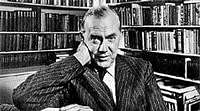

He made sure that books presented to him were always inscribed and signed by the author. Even as a teenager, he sought first editions and signed copies. He knew the value of a book signed by him. He did the book-crawl whenever he could, wandering from auction rooms to antiquarian bookshops to flea markets in England, picking up what felt valuable and beautiful to him. He was constantly swapping his collection, selling or trading an edition for another edition he desired more. And so the number of rare or first editions in his collection never remained the same, often dipping and swelling.
At the time of his death, it numbered nearly 3000, with as many as 500 editions signed or inscribed by the greats of modern literature. When his nephew opened a secondhand bookstore, Greene was behind the inspiration. He often wrote in the margins of books (and a rough estimate is as much as 30,000 margin linings).
We learn of Greene the collector from books that even his most keen readers don’t look to: With All Faults (1973), the autobiography of David Low, a bookseller Green befriended and often bought books from. Green wrote the introduction to the book, reminiscing about their book collecting friendship. The Annotated Library of Graham Greene (1993) catalogues his books and letters. The most revealing is Dear David, Dear Graham: A Bibliophilic Correspondence (1989).
He writes to Low after stumbling on a rare find in Clapham: “…a bookshop near the church on the edge of the common. I bought there for two shillings an Order of Holy Week, date 1668 with plates by Hollar, in a beautiful red morocco contemporary binding. It was dedicated to the Queen… I have still got it and I wonder how much it is worth.”
He often scribbled the sale details of a book. With his lover, Dorothy, who illustrated several of his children’s books, he collected Victorian detective fiction. Another love affair is recorded through the book inscriptions Greene and Catherine Walston made for each other through the years. While still married to Vivien Greene, he dedicated The End of An Affair to ‘C.’
Several of the books she gave him are boldly inscribed, such as in the flyleaf of a fourth impression Augustine’s Confessions: ‘To Graham on Capri May-June 1950 with a Red Cross on the Bottom. With love from Catherine’.
The last years spent in Antibes with his last lover, Yvonne Cloretta, he kept a house filled with books, specially several first and limited editions of his own books. He would often frequent a restaurant here, and once wrote in the copy of Martin Chuzzlewit he happened to be reading while dining: “Two women having dinner at Felix –one has been left by her husband. The other is bored by her husband.” Most of his books and letters are in libraries now. And of course, in the hands of some intrepid collectors.
In A Pound of Paper: Confessions of a Book Addict, film critic and biographer John Baxter records how he became an obsessive book collector because of Graham Greene. While browsing in a London flea market, Baxter noticed an unusually thin looking book dealer in a beret with nicotine stained fingers (“a morning fag guttered in the moist morning air”) who quickly sensed Baxter’s keenness for Greene.
He proffered not one but three rare Greene editions, one of them a British first edition of Our Man In Havana. And he was asking just five pounds for each. The instant he bought the lot, Baxter realised he had gone from being a reader to a collector.
Greene was notorious for not signing books. However, if you surprised him on the street with a fine edition of one of his books, he was known not only to sign it but even leave a long inscription in his spidery handwriting. Baxter would leave his Greene editions with a bookseller whose bookshop the author frequented, and in this way managed to get some of them signed. He was apparently so embarrassed by his first published book, Babbling Brook, a slim volume, that he bought up all existing copies to destroy them – and this well may have been possible since the print run was as small as 300 copies. Few copies exist today in the rare book market, and if one ever turns up it sells for upwards of 5,000 pounds.
Many of his earlier books (Stamboul Train, The Confidential Agent) had short first print runs. Baxter recalls making a find quite unexpectedly at the famous antiquarian bookstore, Maggs. They had only a few Greene editions of note. One in particular caught Baxter’s attention: an inscribed first edition of The Lawless Roads without a dustwrapper for 150 pounds. It wasn’t a very collectible item and without the dust jacket worth even less. But Baxter, now fully into Greene, spotted something the bookshop had missed. It was dedicated, in that spidery Greene hand to the Jesuit priest the author had dedicated “The Power and The Glory” to, making it at once precious. Baxter snapped it up.
Baxter’s fanatical Greene obsession ends on a strange note. Years later he sold his Greene collection to Swann’s book auction gallery for a 200 percent profit. Now his shelves were bare, but he says this only proved an enticement to begin collecting again. ‘The incomplete is always alluring’, he writes. Greene the collector would have understood. In his introduction to With All Faults, Graham Greene himself wrote: “The value of a collection to the collector lies less in its importance, surely, than in the excitement of the hunt, and the strange places to which the hunt sometimes leads.”